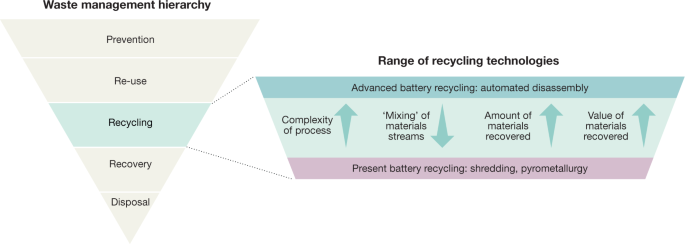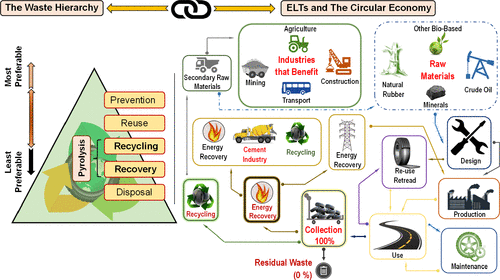Lesson 4 Waste-management hierarchy and circular economy
Waste-management hierarchy and circular economy
The End-of -Life Vehicles (ELV) Directive was introduced to ensure that the waste produced by recycling older vehicles was maintained at sustainable levels. Primarily, car recycling should not only help to remove and store potential toxins from ELVs, it should also breathe new life into used car parts that can continue to be used on other vehicles.
The aim of current European Union waste management directives is to promote the prevention of waste and the application of a waste management hierarchy: preparing for reuse, recycling, other recovery, and disposal.
The following waste hierarchy shall apply as a priority order in waste prevention and management legislation and policy [[i]]:
(a) prevention; (b) preparing for re-use; (c) recycling; (d) other recovery, e.g. energy recovery; and (e) disposal.

2‑1. Figure_Waste management hierarchy for EV battery [[ii]]
The Waste Framework Directive only measures the waste operations recycling, incineration, and landfill individually, not measuring the implementation of the waste hierarchy principle in Member States of the European Union.
Recent studies propose a Waste Hierarchy Index (WHI) to measure waste hierarchy in the context of the circular economy, applied to municipal solid waste [[iii]]. In the development of the WHI, recycling and preparation for re-use, as defined by Eurostat, were considered as positive contributors to the circular economy, and incineration and landfill as negative factors.
The WHI has been applied at different geographic scales (local and national level) to verify its potential and limitations. The WHI is a straightforward and concise indicator that provides a holistic view of how waste is managed.
The WHI is more than a source of waste statistics; it is the beginning of a real discussion about how waste statistics should be managed to reach a circular economy by implementing the waste hierarchy.
Circular Economy Model The waste challenge posed by EV batteries combined with the rapidly increasing demand for raw materials creates a significant opportunity to develop a circular economy.
Applying this framework to EV batteries, the top priorities will be preventing and decreasing the use of resources (particularly rare earth metals) and finding new uses for batteries removed from electric vehicles.

2‑3. Figure_ ELTs management within the circular economy approach
[https://doi.org/10.1021/acs.energyfuels.3c00847]
[[i]] DIRECTIVE 2008/98/EC OF THE EUROPEAN PARLIAMENT AND OF THE COUNCIL of 19 November 2008 on waste and repealing certain Directives, Current consolidated version: 05/07/2018 https://eur-lex.europa.eu/eli/dir/2008/98/oj/eng
[[ii]] Harper, G., Sommerville, R., Kendrick, E. et al. Recycling lithium-ion batteries from electric vehicles. Nature 575, 75–86 (2019). https://doi.org/10.1038/s41586-019-1682-5
[[iii]] Ana Pires, Graça Martinho, Waste hierarchy index for circular economy in waste management, Waste Management, Volume 95, 2019, Pages 298-305, ISSN 0956-053X, https://doi.org/10.1016/j.wasman.2019.06.014. (https://www.sciencedirect.com/science/article/pii/S0956053X19303927)